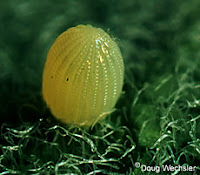Butterfly Life Cycle
The butterfly and moth develop through a process called metamorphosis.
This is a Greek word that means transformation
or change in shape. Insects have two common types of metamorphosis. Grasshoppers,
crickets, dragonflies, and cockroaches have incomplete metamorphosis.
The young (called a nymph) usually look like small adults but without the
wings. Butterflies, moths, beetles, flies and bees have complete
metamorphosis. The young (called a larva instead of a nymph) is
very different from the adults. It also usually eats different types of food. There are four stages in the metamorphosis of butterflies and
moths: egg, larva, pupa, and adult.
 The first stage is egg. Eggs are laid on plants by the adult female butterfly. Eggs can be laid from spring, summer, or fall. This depends on the species of butterfly. Butterfly eggs can be very small.
The first stage is egg. Eggs are laid on plants by the adult female butterfly. Eggs can be laid from spring, summer, or fall. This depends on the species of butterfly. Butterfly eggs can be very small. The second stage is caterpillar or the feeding stage. This is also called a caterpillar if the insect is a butterfly or a moth. The job of the caterpillar is to eat. As the caterpillar grows its splits its skin and sheds it about 4 or 5 times. Caterpillar can grow 100 times their size during this stage.
The second stage is caterpillar or the feeding stage. This is also called a caterpillar if the insect is a butterfly or a moth. The job of the caterpillar is to eat. As the caterpillar grows its splits its skin and sheds it about 4 or 5 times. Caterpillar can grow 100 times their size during this stage. The third stage is pupa. After caterpillar is full grown and stops eating, it becomes a pupa. The pupa of butterfly is also called chrysalis. The pupa of many moths is protected inside a coccoon of silk. This stage can last from a few weeks, a month or even longer. It may look like nothing is going on but big changes are happening inside. Many of the original larva cells will provide energy for these growing adult cells.
The third stage is pupa. After caterpillar is full grown and stops eating, it becomes a pupa. The pupa of butterfly is also called chrysalis. The pupa of many moths is protected inside a coccoon of silk. This stage can last from a few weeks, a month or even longer. It may look like nothing is going on but big changes are happening inside. Many of the original larva cells will provide energy for these growing adult cells.  The last stage is the reproductive stage. The adult stage is what most people think of when they think of butterflies. They look very different from the larva. The adults have long legs, long antennae, and compound eyes. They can also fly by using their colorful and beautiful wings. The adult female can easily fly from place to place to find the right plant for its eggs.
The last stage is the reproductive stage. The adult stage is what most people think of when they think of butterflies. They look very different from the larva. The adults have long legs, long antennae, and compound eyes. They can also fly by using their colorful and beautiful wings. The adult female can easily fly from place to place to find the right plant for its eggs.
Sources:
http://www.ansp.org/explore/online-exhibits/butterflies/lifecycle/
http://foodforever.wikispaces.com/file/detail/A3-Butterfly-Lifecycle%2Bfor%2Bweb.gif/297307042
http://www.ansp.org/explore/online-exhibits/butterflies/lifecycle/
http://foodforever.wikispaces.com/file/detail/A3-Butterfly-Lifecycle%2Bfor%2Bweb.gif/297307042
